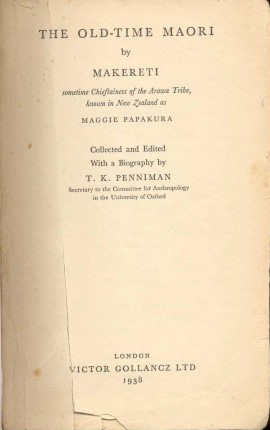
The Old-Time Māori, by Makereti, Sometimes Chieftainess of the Arawa Tribe, Known in New Zealand as Maggie Papakura (1938)

This is the first comprehensive ethnographic account of Māori life by a Māori scholar.
Publication details
Makereti. The Old-Time Māori, by Makereti, Sometimes Chieftainess of the Arawa Tribe, Known in New Zealand as Maggie Papakura. London, UK: Victor Gollancz, 1938.
About the book
Margaret Pattison Thom, who was later widely known as Makereti (or Maggie) Papakura, was born in Matata, in the Bay of Plenty, on 20 October 1873. Her father was an Englishman, William Arthur Thom and her mother was Pia Ngarotu Te Rihi, a high-born Te Arawa woman of Ngati Wahiao hapū of Tuhourangi. Makereti was taken to the rural community of Parekarangi to be raised by her mother’s paternal aunt and uncle, Marara Marotaua and Maihi Te Kakau Paraoa. It was from them that Makereti learnt the genealogies, histories and customs that informed her book, The Old-Time Māori.
Maggie Papakura became a famous hostess and guide to the hot springs and geysers of the Rotorua district. In 1911 she met and married Richard Charles Staples-Brown, a wealthy English land owner, she moved to England and they lived near Oxford. In 1926, Makareti enrolled as a student at the University of Oxford to study for a BSc in anthropology. On 16 April 1930, just weeks before her thesis was due for examination, Makereti died suddenly. Her thesis, The Old-Time Māori was published eight years after her death.
The Old-Time Māori is Maggie Papakura’s biography, the life-story of the old people she was raised by and to whom the book is dedicated. It tells the story of the kainga in which she was born and her own early life. Maggie Papakura narrates her observations from childhood through to her later years covering such areas as whakapapa, the record of marriages and births; rituals such as the tohi rite over children and collection and cultivation of food.
The book has a unique place as the first extensive published ethnographic work by a Māori scholar. The most striking quality about the book is that while scholarly in approach, it is based on traditionally acquired knowledge and first-hand experience. Moreover, it reflects the self-awareness of its author who was at all times conscious of her lineage and responsibility to her people.
Further information
This publication is part of the series Te Takarangi: Celebrating Māori publications - a sample list of 150 non-fiction books produced by a partnership between Royal Society Te Apārangi and Ngā Pae o te Māramatanga.
